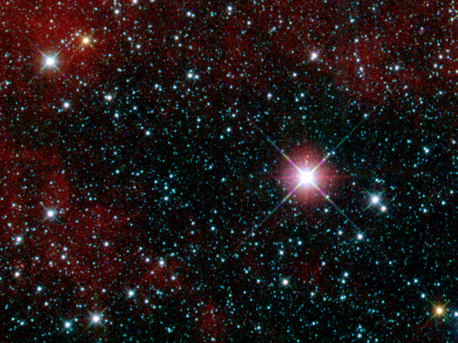New Space Telescope
WISE Eyes Spy Starry Sky
 © NASA/JPL-Caltech/UCLA |
This infrared snapshot of a region in the constellation Carina near the Milky Way was taken shortly after NASA's Wide-field Infrared Survey Explorer (WISE) ejected its cover. The "first-light" picture shows thousands of stars and covers an area three times the size of the moon. WISE will take more than a million similar pictures covering the whole sky.
The image covers a patch of sky about three times larger than the full moon. The patch was selected because it does not contain any unusually bright objects, which could damage instrument detectors if observed for too long. The picture was taken while the spacecraft was staring at a fixed patch of sky and is being used to calibrate the spacecraft's pointing system.
When the WISE survey begins, the spacecraft will scan the sky continuously as it circles the globe, while an internal scan mirror counteracts its motion. This allows WISE to take "freeze-frame" snapshots every 11 seconds, resulting in millions of images of the entire sky.
"Right now, we are busy matching the rate of the scan mirror to the rate of the spacecraft, so we will capture sharp pictures as our telescope sweeps across the sky," said William Irace, the mission's project manager. To sense the infrared glow of stars and galaxies, the WISE spacecraft cannot give off any detectable infrared light of its own. This is accomplished by chilling the telescope and detectors to ultra-cold temperatures. The coldest of WISE's detectors will operate at less than 8 Kelvin, or minus 445 degrees Fahrenheit.
The first sky survey will be complete in six months, followed by a second scan of one-half of the sky lasting three months. The mission ends when the frozen hydrogen that keeps the instrument cold evaporates away, an event expected to occur in October 2010.
Preliminary survey images are expected to be released six months later, in April 2011, with the final atlas and catalog coming 11 months later, in March 2012. Selected images will be released to the public beginning in February 2010.
Source: NASA, JPL
New Space Telescope
WISE Eyes Spy Starry Sky
 © NASA/JPL-Caltech/UCLA |
This infrared snapshot of a region in the constellation Carina near the Milky Way was taken shortly after NASA's Wide-field Infrared Survey Explorer (WISE) ejected its cover. The "first-light" picture shows thousands of stars and covers an area three times the size of the moon. WISE will take more than a million similar pictures covering the whole sky.
The image covers a patch of sky about three times larger than the full moon. The patch was selected because it does not contain any unusually bright objects, which could damage instrument detectors if observed for too long. The picture was taken while the spacecraft was staring at a fixed patch of sky and is being used to calibrate the spacecraft's pointing system.
When the WISE survey begins, the spacecraft will scan the sky continuously as it circles the globe, while an internal scan mirror counteracts its motion. This allows WISE to take "freeze-frame" snapshots every 11 seconds, resulting in millions of images of the entire sky.
"Right now, we are busy matching the rate of the scan mirror to the rate of the spacecraft, so we will capture sharp pictures as our telescope sweeps across the sky," said William Irace, the mission's project manager. To sense the infrared glow of stars and galaxies, the WISE spacecraft cannot give off any detectable infrared light of its own. This is accomplished by chilling the telescope and detectors to ultra-cold temperatures. The coldest of WISE's detectors will operate at less than 8 Kelvin, or minus 445 degrees Fahrenheit.
The first sky survey will be complete in six months, followed by a second scan of one-half of the sky lasting three months. The mission ends when the frozen hydrogen that keeps the instrument cold evaporates away, an event expected to occur in October 2010.
Preliminary survey images are expected to be released six months later, in April 2011, with the final atlas and catalog coming 11 months later, in March 2012. Selected images will be released to the public beginning in February 2010.
Source: NASA, JPL





